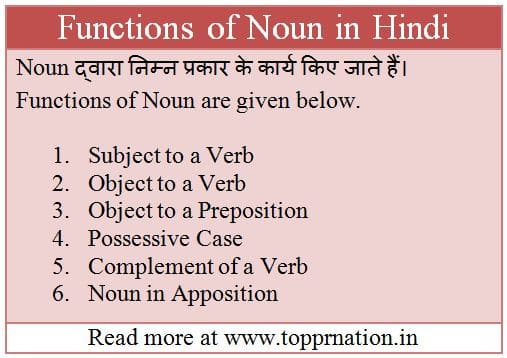Functions of Noun in Hindi – Rules and Examples in English Grammar, संज्ञा के कार्य हिंदी में, Learn about Nominative Case, Objective Case, Possessive Case, Complement and Vocative Case in Hindi.
Functions of Noun
Noun द्वारा निम्न प्रकार के कार्य किए जाते हैं। Functions of Noun are given below.
- Subject to a Verb
- Object to a Verb
- Object to a Preposition
- Possessive Case
- Complement of a Verb
- Noun in Apposition
Subject to a Verb
किसी Noun का प्रयोग क्रिया के रूप में होने पर वह Nominative Case में होता है, वह Noun उस Verb का Subject कहलाता है।
Examples:
1. Reeta cooks the food. (रीता खाना पकाती है।)
2. Sohan washes the clothes. (सोहन कपड़े धोता है।)
3. The girl sings a song. (लड़की गाना गाती है।)
4. The teacher teaches the students. (अध्यापक बच्चो पढ़ाता है।)
Note: उपर्युक्त वाक्यों में 1 Reeta – Subject of the sentence और cooks – verb of the subject है। वाक्य 2 में Sohan – Subject of the sentence और washes – verb of subject है। वाक्य 3 में The girl – subject of sentence और sings – verb of subject है।
Read also:
- Nouns in Hindi,
- Singular and Plural Noun
- the Case
- Proper noun in Hindi
- Common Nouns in Hindi
- Collective Noun in Hindi
- Material Noun in Hindi
- Noun Exercises with Answers and Worksheets
Object to a Verb
किसी Noun का प्रयोग वाक्य की क्रिया के कर्म के रूप में होने पर वह कर्म कारक (Objective Case) होता है।
Examples:
1. Geeta reads a book. (गीता पुस्तक पढ़ती है।)
2. Sachin won the match. (सचिन ने मैच जीता।)
3. Deepak gave me a ball. (दीपक ने मुझे एक गेंद दी।)
4. She opened the door. (उसने दरवाजा खोला।)
Note: उपर्युक्त वाक्यों में 1. ‘a book’ verb ‘reads’ का object है। 2. ‘the match’ verb ‘won’ का object है। 3. ‘a ball’ verb ‘gave’ का object है। 4. ‘the door’ verb ‘opened’ का object है।
अतः जो Nouns क्रिया के बाद आते हैं वे object का कार्य करते हैं।
Object of a Preposition
जो Noun किसी Preposition के बाद आते हैं वे उस Preposition के Object कहलाते हैं।
Examples:
1. She goes to market. (वह बाजार जाती है।)
2. He sleeps in the room. (वह कमरे में सोता है।)
3. They jumped upon the table. (वे मेज पर कूदे।)
Note: उपरोक्त वाक्यों में to के बाद market आया है, in के बाद the room आया है तथा upon के बाद the table आया है।
अतः इन Prepositions के बाद आने वाले सभी Nouns Object हैं। इन Nouns का प्रयोग Objective Case में है।
Possessive Case
किसी Noun से संबंध या अधिकार प्रकट करने पर Possessive Case होता है।
Examples:
1. John’s house. (जॉन का घर)
2. Seeta’s son (सीता का पुत्र)
3. Women’s Park (महिलाओं का पार्क)
4. Boys’ hostel (लड़कों का हॉस्टल)
5. Girls’ College (लड़कियों का कॉलेज)
Complement to a Verb
जब किसी Noun या Adjective का प्रयोग is, am, are, was, were के बाद होता है तो वह complement कहलाता है। कॉन्प्लीमेंट (Complement) का प्रयोग वाक्य अर्थ का पूरा करने के लिए होता है।
Examples:
1. She is a girl. (वह एक लड़की है।)
2. The boy is a doctor. (लड़का डॉक्टर है।)
3. My country is great. (मेरा देश महान है।)
4. You are a driver. (तुम एक ड्राइवर हो।)
5. Water is life. (जल जीवन है।)
Note: उपर्युक्त वाक्यों में a girl, a doctor, a driver, life Nouns हैं तथा Complement का कार्य कर रहे हैं।
Noun in Apposition
जब दो Nouns से एक ही कि वस्तु या व्यक्ति प्रकट हो तो बाद वाले का वही Case होगा जो पहले वाले होगा। अर्थात दोनों Nouns का प्रयोग एक ही Case में होगा। ऐसे प्रयोग में Case in Apposition होता है।
Apposition means placing near.
Examples:
1. Ram, our captain, is not playing the game.
2. Gandhiji, father of nation, used to visit Ashram.
Note: उपर्युक्त वाक्यों में से एक में Ram और our captain एक ही व्यक्ति है। दूसरे वाक्य में Ghandiji और father of nation एक ही व्यक्ति हैं।
Read about Parts of Speech, Subject and Predicate, Pronouns, Grammar in Hindi
- Easy Hindi to English Translation - March 20, 2024
- Present Tense in Hindi – परिभाषा, प्रकार तथा उदाहरण - March 17, 2024
- Personal Pronoun in Hindi – Definition, Examples and Rules - March 8, 2024


Very good 👍